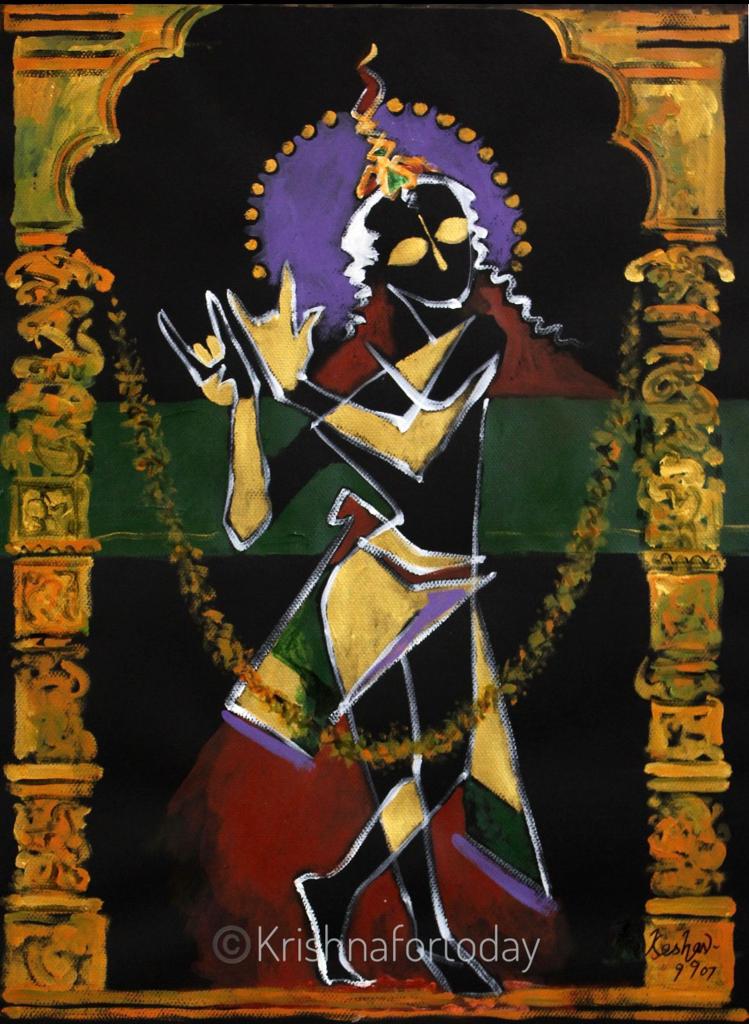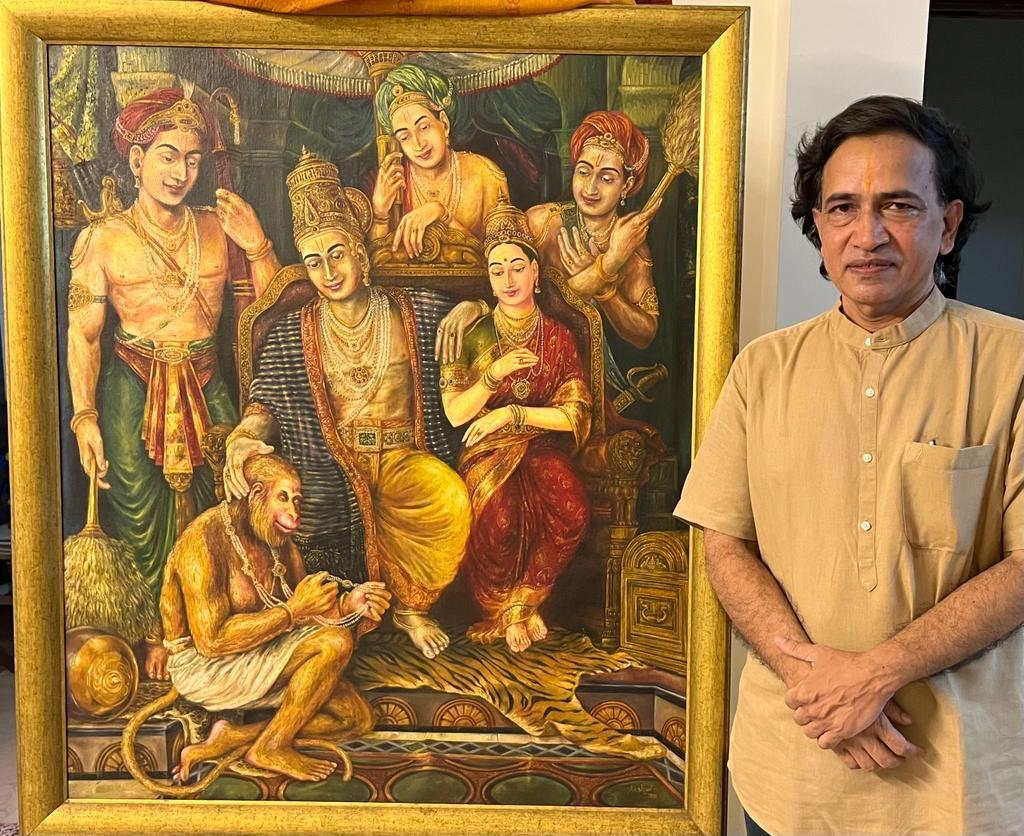Krishna is not confined to geographical boundaries. I call him Universal Krishna – Artist Keshav Venkataraghavan shares how his learnings from Indian, other Asian and western art forms manifest in his paintings of Lord Krishna, who he says is the fulcrum of everything
Written by Rajeshwari Kalyanam
The idea of Krishna is not dependent on time and space.
It is always relevant.
As happiness is.
It will be renewed and revitalised on its own.
Artist Keshav Venkataraghavan is from Chennai, and for over decades now, this self-taught artist, sees Krishna in everything, every form, and every thought. He transfers his imagination, understanding, and consciousness onto the canvas where art meets spirituality resulting in vibrant paintings, that carry a distinctive signature style.

Artist Keshav says, “I have been drawing Krishna since 2002, and over the years my art has evolved. One keeps changing with time – the work, and through oneself, and keeps evolving.”
So, you see him using different techniques, mediums, and themes, and above all you see various influences of different schools of art that have made an impact on this self-taught artist – from Renaissance to post-modern, from Western art to Asian and the various folk forms from across the world and even the dance, and music, and the sculptural and scriptural heritage of India.
Keshav has been attracted to art and drawing since when he was a child. Interestingly, this Chennai-based artist grew up in Hyderabad. He lived in Domalguda, attended KV Golconda, and learnt art from BA Reddy.
He has worked as an artist with magazines and has been with The Hindu newspaper as a cartoonist for three decades, and says cartoonist and filmmaker Bapu has been one of his influences.
Over the years he has painted the omnipresent Krishna so many times, and yet it is amazing how each time we see a different facet of Krishna tatvam. It could be a nuanced expression of devotion or emotion; one gets to visualise it all in his paintings. A variety of mediums like water colours or oil on canvas or just ink sketches, visible influences of Picasso or a Rembrandt, Kolkata’s Kalighat, Patachitra of Odisha, or the Indian schools of art, heavily embellished iconography or just a semi-abstract form, Keshav’s obsession with Krishna is on glorious display in his artworks. Krishna painted in Keshav’s brush over the years has transformed, and journeyed along with his experiences, which you get to see on his website ‘Krishna For Today’.

Keshav shares his art journey – “From the time I was very young, going to school, art was part of my natural homework.
I did college through correspondence. That gave me time to study art. I would go to libraries and read literature on art, most of which was from the British and American Counsels.
I would explore the impressionist, Renaissance, all of European art, and Raja Ravi Varma’s work until I discovered S Rajan’s work. He studied under Deviprasad Chowdhary from Madras School. S Rajan turned my interest towards Indian art -it has so much symbolism, philosophy, metaphors, and Similies – there was a treasure unfolding in front of me, and all stories are so visual that encourage one to think.
I began to work with Indian mythology. I learned my techniques from the European Masters – Matisse, Constable, Vangogh – and I was also learning the medium.
But Indian art opened up another world of creativity to me – there is so much like the Pahadi, Mithila, Tanjore, Kerala Murals, Odisha Patachitra, the Bengal, Madras, and Baroda Masters., Ganesh Pyne has been major influence.”

He elaborates on how academic realism and Western principles of anatomy gave way to studying Asian and Oriental art, and why the latter appeals to him more, “There is so much to learn from India, especially south India – from the sculptures – from Mesopotamia to Angkor – it’s all the same. We don’t have a culture of modeling. We do art from memory and give it our perception. And, this appealed to me more. In 2000, I started exploring Indian art, I started to work on Indian art in 2002 and began to focus on Krishna in 2006.”
“Krishna is the fulcrum around which everything circles. Learning mythology opens innumerable possibilities. Working on Krishna brings all elite arts together – making connections between music, drama, dance, sculpture, architecture.”
“I continued to read and learn. I studied a treatise on painting – Chitra Sutra – an appendix to Vishnu Dharmottara Purana, which is considered to be everything about art. As I learn more things that also changes the way I do art. I started off with only abstracts of Krishna as I knew I was still exploring. When I started drawing from earlier works, many of which have been destroyed, and some are there in foreign museums – it was the technique I was exploring first. I was also studying the old masters. This I do so that I can extend my repertoire.” He shares.
For Keshav, Krishna and art are about continuous exploration. And, when he begins to work, it is only towards the end that he knows what shape it has taken. You see Indian, European, and Far East Asian influences too in his work. A look through his Dialogue with Arjuna series where you see Parthasarathy guiding Arjuna with Gitopadesam – it is amazing the way he has explored emotions, forms, mediums, and various schools of art. In one of the works you see a Chinese Krishna in the form of a monk.

Keshav has been working on Krishna for many years now. We ask – What does Krishna mean to him?
“He is everything,” he says. “I don’t see Krishna confined to geographical boundaries. I call him Universal Krishna.
Yat Bhavam Tat Bhavathi – He becomes what he thinks. He is the center of everything. He is within us. We refer to him as Ananda Swaroopa – and everyone desires Ananda. We cannot even assign a gender to the Supreme.”












